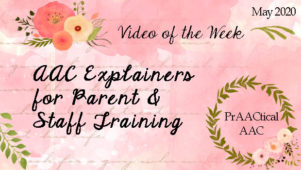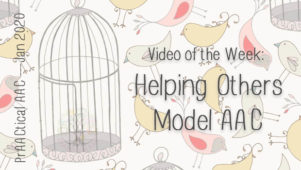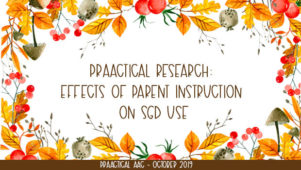Building AAC Facilitation Skills with Tabi Jones-Wohleber: MASTER PAL Training, Module 10 (Appropriate Prompting)
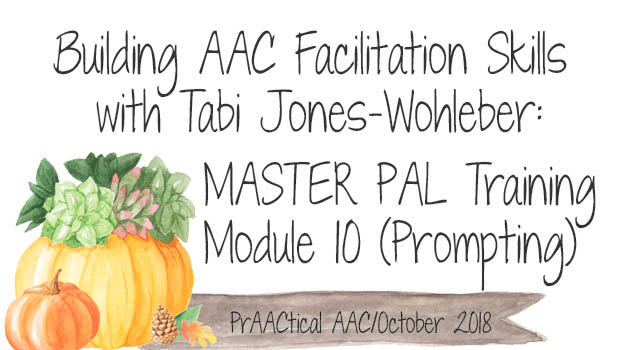
 The right types of prompts delivered at the right time in the right amount can be enormously powerful in supporting AAC learners. On the other hand, the wrong type of prompt or prompts that offer too much or too little help can impede learning, self-confidence, and cause other problems as well. In today’s continuation of the Model as a MASTER PAL Training Series, Tabi Jones-Wohleber addresses issues related to prompting. As with the other modules, she provides slides, handouts, video links, discussion points and more. This module should take about 30-40 minutes to present.
The right types of prompts delivered at the right time in the right amount can be enormously powerful in supporting AAC learners. On the other hand, the wrong type of prompt or prompts that offer too much or too little help can impede learning, self-confidence, and cause other problems as well. In today’s continuation of the Model as a MASTER PAL Training Series, Tabi Jones-Wohleber addresses issues related to prompting. As with the other modules, she provides slides, handouts, video links, discussion points and more. This module should take about 30-40 minutes to present.
Looking for the earlier modules in the MASTER PAL Series? Check them out here.
::::::::::::::::::::::::::::::::::::::::::::::::::::::::::::::::::::::::::::::::::::::::::::::::::::::::::::::::::::::::::::::::::::
Model as a MASTER PAL
Module 10: Appropriate Prompting
Facilitator Guidelines
What it comes to prompting, it’s important to get it right! Inappropriate prompting can result in decreased quality interactions characterized by prompt dependence, passive engagement, and of course poor use of communication tools. This module provides an overview of types of prompting, as well as the role of context when prompting. With a nod to Kate Ahern’s contributions to the field on this topic, the importance of motivation and wait time at every stage of the prompting hierarchy is emphasized. Hand-under-hand prompting is explored as it provides the perceived benefits of hand-over-hand, and is less intrusive. Appropriate prompting provides positive practice to maximize communication and learning. When done well it provides an individual the space to recognize that his AAC device is truly his voice.
For this module, you will need the following:
 Warm-up Discussion
Warm-up Discussion
| Thinking Prompt | Making Connections / Talking Points |
Think of a student who uses AAC. What level of prompting does this student require to:
|
This is an animated slide. Examples appear one-at-a-time.
Introduce this slide by stating that it will be useful to have a student or small group of students in mind for the discussion. We will be discussing how they use their AAC devices in different contexts.
This discussion illustrates that different types and levels of prompting may be required by a single student depending on context. A student cannot be solely described by the level of prompting he/she requires, because use of prompting is dynamic and context-specific. If the progression of the conversation does not seem to apply to some students due to great progress, ask participants to think back to the levels of prompting the student previously required to get to this point. |
The Discourse
| Topics Addressed | Slide(s) | Talking Points / Examples |
| Title Slides | 1-2 | N/A |
| Communication Review | 3-7 | Review of Model as a MASTER PAL and AAC to ensure all participants are on the same page |
| Introduction | 8-9 | Prompting shapes learning to create positive practice. Autonomy is the goal. |
| Types of Prompting | 10 | The type of prompt describes the action of the communication partner to elicit interactions. Within each type of prompt, the level of support required may be minimal to maximal. |
| Warm-Up Discussion | 11 | Explained on Slide.
See chart above for Warm-up Discussion |
| Prompt Hierarchy & Prompt Dependence | 12-14 | Explained on Slides.
Bottom-line: Prompting is a thoughtful process. Over-prompting creates prompt dependence |
| Prompt Hierarchy Handout | 15 | Consider providing this handout to participants for discussion.
This prompt hierarchy, developed by Kate Ahern, is notable in 2 ways:
|
| Reasons to avoid hand-over-hand | 16 | Explained on slides.
One point of discussion may be the need to help the student build a motor plan to access words and phrases. The problem is this: when someone takes your hand, what do you do? You either pull -back or relinquish control. When you resist, the energy exerted undermines any firing of motor neurons to learn a motor pattern. If you relinquish control, you are in no way invested in your role in the task, and therefore, not learning the motor pattern. |
| Benefits of hand-under-hand | 17 | Explained on the slide.
In summary, hand-under-hand ACTUALLY provides the perceived benefits of hand-over-hand.
Click on the links and video icon for additional information and examples. |
| Prompt Dependence | 18 | Explained on slide. |
| Food-for-thought | 19 | Expectant Pauses are a POWERFUL prompt and should be used liberally. Expectant Pauses and Looks show the student you are patient with their attempts, won’t rush them and value what they have to say. It also sends a clear message that communicating is a 2-way street. For students who perceive they will be “off the hook” if they don’t immediately respond it compels greater responsibility in the interaction. |
| Modeling as a prompt and a teaching strategy | 20 | Explained on slide.
Modeling is 2 things. A teaching strategy and a type of prompting. Just remember that the goal of prompting is to elicit a response. Modeling can be a part of the hierarchy. It can (& should!) also occur outside of the hierarchy as an essential teaching strategy for AAC |
| Tools vs. Prompts | 21 | Explained on slide.
One way to make this relatable is to reference the fact that with many students we use picture schedules. We use various types and levels of prompts to teach students to use their schedules with increased independence. As adults, we ALL use calendars (in some form). Both picture schedules and calendars are tools. But challenge any adult in the room to give up their calendar and I assure you there will be no takers. We are dependent on our tools! |
| Re-visiting the goal of prompting | 22 | Self-determination paves the way for self-actualization. Providing tools and supporting autonomy through a supportive prompting hierarchy are needed to teach AAC (among other skills). Effective prompting is executed thoughtfully with these goals in mind. |
| Let’s Re-Cap | 23 |
|
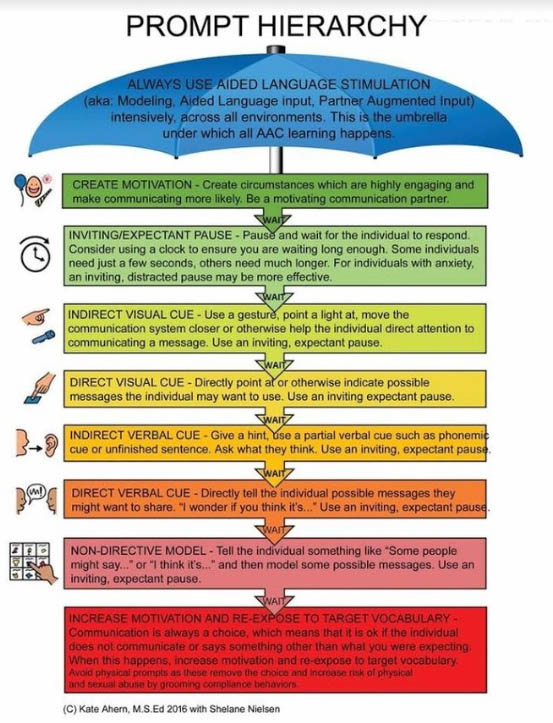
Supplemental Handouts
Video Links
Interactive Activities/Discussions: See Warm-Up Discussion
Extension Activities
- AAC Language Lab- Prompt Hierarchy Chart (requires subscription)
Resources→ Speech Pathologist→ AAC Resources
Filed under: Featured Posts, PrAACtical Thinking
Tagged With: AAC partner training, prompt hierarchy, prompting, Tabi Jones-Wohleber
This post was written by Carole Zangari

